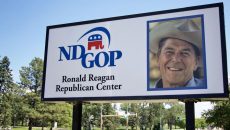Tom Steyer’s epic fail went from one Washington to the other

By Rob McKenna
Here in Washington state, it takes a little longer to count votes than in other states. Ballots need only be postmarked by election day to be counted. So we are still waiting for final results a week after our all-mail campaigns ended.
And though votes are still being counted here, one thing is perfectly clear — Tom Steyer was the big loser, along with his goal to have Washington join California as a low-carbon fuels standard and and-trade state. Washingtonians will not see their energy prices skyrocket thanks to an out-of-state intruder.
BIG LOSS: In this year’s mid-term elections Tom Steyer was the biggest loser of all.
Steyer’s national story already has been written: how the California hedge-fund billionaire and his super-PAC, NextGen Climate Action, epically failed despite spending $70-plus million across the country trying to keep the Democrats in control of the U.S. Senate and defeat multiple incumbent Republican governors.
Instead, the GOP will take majority control — with at least four votes to spare — of the U.S. Senate in January, and there will be three more states led by Republican governors than this year.
The results in Washington state were even more devastating to Steyer’s desire to make climate change the defining issue of the election.
He has spent some $2 million in the past 14 months trying to deliver a state Senate majority to environmental fellow traveler Gov.Jay Inslee and has lost in all five races his money was involved in, including four this year.
The bipartisan coalition governing the Senate not only remains at 26-23 heading into 2015, but the Republican now have an outright majority, having gained a new member in each of the plast two years (to go along with a maverick Democrat senator who withstood Steyer’s attacks).
Additionally, Steyer’s investment in strengthening the Democrats’ state House majority also fell flat.
Republicans appear to have gained four seats, knocking off four incumbents, and are within 300 votes of capturing an open seat. Even assuming that fifth race stays in the Democrat column, the Democrats will see their margin in the House reduced to 51-47, allowing the minority Republicans to team up with more moderate, rural Democrats to stymie the Steyer-Inslee climate agenda.
The Washington ztate GOP can be emboldened by the fact that — despite Steyer’s millions spent in attack ads, in conjunction with union and trial lawyer efforts — every one of its elected House incumbents won by at least 10 points, and all four of the targeted senators took 53 percent or more in their races.
The result means both Washingtons can breathe a sigh of relief.
Political contributions are an expression of the freedom of speech we cherish in this country, but Steyer’s heavy spending in this year’s midterm elections was enough to make thoughtful people apprehensive about the health of our political institutions.
Many of us on the free market side watched with great nervousness as the money poured into state and federal campaigns during the final weeks of the campaign. As TV ads flooded the airwaves, canvassers pounded on doors and political fliers stuffed mailboxes in the most-hotly-contested districts of our state, we heard a perplexing silence from our colleagues on the other side of the aisle. Steyer’s big-spending effort got a pass from those who have complained the loudest about corporate contributions, the Supreme Court’s Citizens United ruling, and favorite bogeymen like the Koch Brothers, because Steyer was spending for Democrats in the name of a favorite liberal cause: climate change.
Election night ought to tell us that money isn’t everything. We were right to be concerned on the macro level, but the electorate resisted this blunt-force effort by an out-of-state interest to buy an election. We weathered the storm. Certainly this year’s campaigns were harder-fought than usual.
But if we can borrow a phrase from Al Gore’s unsuccessful presidential campaign of 2000, it was a triumph of the people over the powerful. The outcome ought to give us faith that our democracy can survive.
Washington state was a microcosm of what was taking place nationwide. Our state Senate is the only legislative chamber on the West coast in which Republicans control the debate. Steyer’s political goal was clear — early on he plotted election strategy in the governor’s mansion with Inslee, who has likewise made climate change his signature issue.
Washington’s Senate is rightly skeptical of proposals for policies like and-trade and low-carbon fuel standards, which might add a dollar or more to the price of gasoline and put a brake on economic growth, for uncertain benefit. If Washington state were under one-party control, lawmakers might be more compliant.
It’s a little hard to trace the direct impact of Steyer’s money in the handful of competitive Senate races this year, because his money was funneled through multiple political committees, with no direct spending against candidates by Steyer’s PAC.
But we can reasonably say Steyer helped fuel wild independent spending this year that contributed to one of the nastiest elections in Washington history. Steyer’s money, unfortunately, contributed to an anything-goes atmosphere, and the most troubling thing is that an out-of-state interest doesn’t have to live with the polarization this sort of political debate helps create.
For instance, Steyer’s PAC contributed $750,000 to the Washington Conservation Voters, which was behind one of the most bald-faced attacks of the campaign. In that suburban Seattle race, between incumbent Sen. Andy Hill, R-Redmond, and Democratic challenger Matt Isenhower, a Conservation Voters flier claimed Hill had “refused to close a single one of the 650 wasteful corporate tax loopholes on the state books.”
Certainly that isn’t a fair description of Washington’s system of tax exemptions and preferential rates, but more importantly, it isn’t true. Hill, the Senate Ways and Means chairman, had supported elimination of a number of tax preferences.
In another of those targeted races in suburban Tacoma, between Sen. Steve O’Ban, R-Lakewood, and Democratic challenger Tami Green, an independent-campaign flier for Green reprinted an editorial from the local newspaper, the News Tribune, that criticized some mailers sent by an independent campaign for O’Ban. Yet the flier mysteriously omitted a phrase that noted O’Ban had nothing to do with them, and failed to mention that the paper had endorsed O’Ban. Anyone looking at it might have gotten the opposite impression.
In a south Puget Sound race, state Sen. Tim Sheldon, D-Potlatch, the maverick Democrat who votes with the Senate Majority Coalition Caucus, was targeted by a curious Democratic flier that praised his votes for reproductive rights, access to health care and tuition for the children of undocumented immigrants. However, that mailer was sent to Republican voters, since following Washington’s unusual top-two primary there were only two Democrats on the general election ballot.
But the worst of the worst was a flier that circulated in a Senate race in the suburbs south of Seattle, where Mark Miloscia, a former Democratic state representative, was running as a Republican. Miloscia, a Catholic, says his former party had no room for a member who takes conservative positions on social issues like abortion and gay marriage. The flier showed Miloscia in a papal hat and noted that he was a lobbyist for the Catholic church: “Rather than represent the people of Federal Way, he has best represented the people of The Vatican.”
Washington’s voters were properly appalled. In Nov. 4’s election, all the targets of these outside attack campaigns won their races. The fact that Washington voters rejected this attempt at manipulation should make us proud.
Rob McKenna, an attorney in private practice, served as Washington’s attorney general from 2005 to 2013, and was Republican candidate for governor in 2012.







